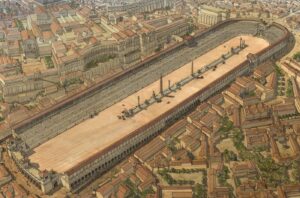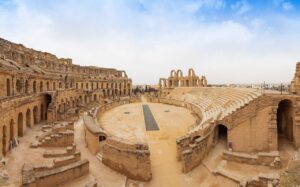
 The Circus Maximus, which is Latin for largest circus is an ancient Roman chariot-racing stadium and mass entertainment venue in Rome, Italy. It is located in the valley between the Aventine and Palatine hills, and it was the first and largest stadium in ancient Rome and its later Empire. It measured 2,037 feet in length and 387 feet in width and could accommodate over 150,000 spectators. In its fully developed form, it became the model for circuses throughout the Roman Empire. The site is now a public park. In its beginning, it might have been planned for good, clean-cut entertainment, but in at least part of its history, it was used for much more sinister things. It was during the Roman Empire, when the empire decided that anyone who was not a Roman citizen was basically unimportant.
The Circus Maximus, which is Latin for largest circus is an ancient Roman chariot-racing stadium and mass entertainment venue in Rome, Italy. It is located in the valley between the Aventine and Palatine hills, and it was the first and largest stadium in ancient Rome and its later Empire. It measured 2,037 feet in length and 387 feet in width and could accommodate over 150,000 spectators. In its fully developed form, it became the model for circuses throughout the Roman Empire. The site is now a public park. In its beginning, it might have been planned for good, clean-cut entertainment, but in at least part of its history, it was used for much more sinister things. It was during the Roman Empire, when the empire decided that anyone who was not a Roman citizen was basically unimportant.
As it has been throughout history, the Roman Empire was notorious for its persecution of Christian and Jewish people. During those years, the Circus Maximus was used for the execution of Christian and Jewish prisoners, as part of the Roman Triumph, along with chariot racing, of course. As we all know, the Roman Empire worshiped a number of gods, which put them in direct conflict with the one true God, and thereby, put them at odds with the Christians and Jews. During those years, Christians were persecuted and prosecuted, throughout the Roman Empire.
Pagan practices such as making sacrifices to the deified emperors or other gods were abhorrent to Christians as their beliefs prohibited idolatry. When they would not comply with the pagan practices, they were prosecuted by the state and other members of civic society and severely punished for “treason, various rumored crimes, illegal assembly, and for introducing an alien cult that led to Roman apostasy.” The first, localized Neronian persecution occurred under Emperor Nero (BC54-BC68) in Rome. A more general persecution occurred during the reign of Marcus Aurelius (BC161-BC180). After a lull, persecution resumed under Emperors Decius (BC249–BC251) and Trebonianus Gallus (BC251–BC253). The Decian persecution was particularly extensive. The persecution of Emperor Valerian (BC253–BC260) ceased with his notable capture by the Sasanian Empire’s Shapur I (BC240–BC270) at the Battle of Edessa during the Roman–Persian Wars. His successor, Gallienus 
 (BC253–BC268), halted the persecutions. Most, if not all of these emperors were viciously wicked men, including Gallienus, who finally stopped this horrific practice. Nevertheless, he did stop it, so that is a good thing. There is a right and wrong way to put someone on trial, and most importantly, there should always be freedom of religion, but not all countries allow freedom of religion.
(BC253–BC268), halted the persecutions. Most, if not all of these emperors were viciously wicked men, including Gallienus, who finally stopped this horrific practice. Nevertheless, he did stop it, so that is a good thing. There is a right and wrong way to put someone on trial, and most importantly, there should always be freedom of religion, but not all countries allow freedom of religion.


Leave a Reply